Pilot project of a light tank UDES XX 20 (Sweden)
As part of the next project being developed as part of the UDES program (Underlagsgrupp Direkt Eld Stridsfordon - “Land Combat Vehicle Shooting Direct-Impact”), the main requirements for a prospective articulated tank were identified. To increase mobility, the car had to have two separate hulls with its own tracked propellers. The front was proposed to equip the gun installation and crew jobs. The rear section, in turn, was designed to accommodate the power plant and some elements of the armament complex.
Works on a new experimental project started in 1977 year, however, until a certain time, construction and testing of a prototype machine was not planned. The project of the new combat vehicle received the designation UDES XX 20. The letters "XX" meant Extra Experimental and indicated the trial nature of the development. It was assumed that the new project will test and improve existing structures, but will not “qualify” for mass production. Nevertheless, with the development of a new version of the tank could count on additional refinement and subsequent adoption.
Tests of two prototypes of the UDES XX 5 tank showed that the articulated circuit has a number of characteristic advantages over the traditional layout. At the same time, there were some disadvantages that negatively affected mobility. Nevertheless, it was decided to continue the development of this design. The model of the gun mount, tested at the test site, was also not without claims. So, it was decided to abandon the hard mounting gun. To enhance combat performance, it was necessary to use a full-fledged combat module with systems of horizontal and vertical guidance. The gun lead by moving the body was considered inconvenient. In particular, it did not allow shooting on the move, and also imposed other restrictions on the combat use of technology.
Preliminary work on the project UDES XX 20 continued until the early eighties. At the same time, technical requirements were used, which were formed at the beginning of the seventies by FMV control specialists. The tank was supposed to have a combat mass of about 20-25 and carry a 105 caliber gun. In the early eighties, the requirements were adjusted. Now the customer wanted to see a tank of the same mass, but with enhanced armor and "main caliber" in the form of a smooth-bore gun caliber 120 mm. Such technical requirements at this time should be connected with articulated layout, which in itself was not a very simple task.
The result of updating the technical specification was the appearance of an improved version of the project, according to which it was planned to build a prototype in the future. From the available data it follows that the revision of the requirements for the project did not require a serious redesign of the machine design. Individual elements of the tank had to be changed, increasing and strengthening them. General features of the design, however, remained unchanged. Thanks to this, we managed to speed up the creation of an improved version of the project to a certain extent.
The project UDES XX 20 proposed the use of two buildings of similar design. The hulls should have large inclined front sheets. In front of the upper frontal parts joined rectangular bottom sheets. The hull had developed nadgusenichnye niche trapezoidal cross-section, supplemented by side screens. It was suggested the use of vertical feed sheet. Protection of the tank was to be provided with rolled homogeneous armor with a thickness of up to 20 mm in frontal projection. Other hull elements were 6 mm thick. The use of a combined reservation with an appropriate level of protection was not intended.
The layout of the two buildings was seriously different. In addition, in connection with a different set of equipment, the two hulls should have been distinguished by some design features. Thus, the frontal part of the front section was only responsible for protecting the crew and internal units, which, unlike the rear hull, did not have any additional devices. In front of the first section, there were transmission elements associated with front-wheel drive wheels. Behind the transmission compartment there was a manned volume to accommodate the crew. In the stern, mounts for the tower with an instrument were provided.
The frontal part of the rear section has received a set of fasteners for mounting the hinge elements connecting the body. There was also a window for outputting the cardan shaft. A noticeable difference in the rear case was the modified shape of the sloping part of the sides: on these sheets were rectangular projections. The rear case was designed to install the engine and the main elements of the transmission. In addition, it was proposed to install various devices of the hydraulic system, as well as means for supplying the working fluid to the hinge cylinders. In the rear case it was planned to place part of the automatic recharge system for the gun, but the prototype built later did not receive such equipment.
In the second building they placed a Detroit Diesel 8VA-71TA hp diesel engine with a capacity of 600 hp, designed both for moving the car and for use as an energy source for hydraulic system pumps. Next to the engine were various transmission devices needed to deliver torque to all four tracks. With the help of the gearbox and transfer case, the power was output to the own elements of the rear section transmission. In addition, part of the power through the drive shaft went into the front housing, where it was redirected to the appropriate device. Thus, all four tank tracks were leading, which should have a positive impact on its mobility.
Both hulls should have been equipped with the same chassis. In their composition were the front drive wheels of small diameter. The use of three large-diameter road wheels with an individual suspension on each side was also envisaged. In the stern were large guide wheels, also lowered to the ground level.
The two bodies were to be interconnected by means of a special hinge, which was a further development of the existing system. In the lower part of the stern of the front section and the front rear sheet were placed devices for connecting the two hulls, which allowed them to swing relative to each other. On the upper part of the stern of the front section there were fastenings for installing the piston of the control hydraulic cylinder. The cylinder itself should be mounted on the top of the forehead of the rear case. Such a position of the hydraulic cylinders made it possible to change the position of the bodies with all the necessary methods. The differentiated work of the cylinders made the car bend to perform in turn. Simultaneous release of pistons forced the central part of the tank to rise up, while the reverse process led to the rise of the nose and the stern, based on the "internal" parts of the tracks. All these possibilities were proposed to be used for maneuvering and overcoming obstacles. In addition, the movement of the front section could be used to increase the pickup angle of the gun.
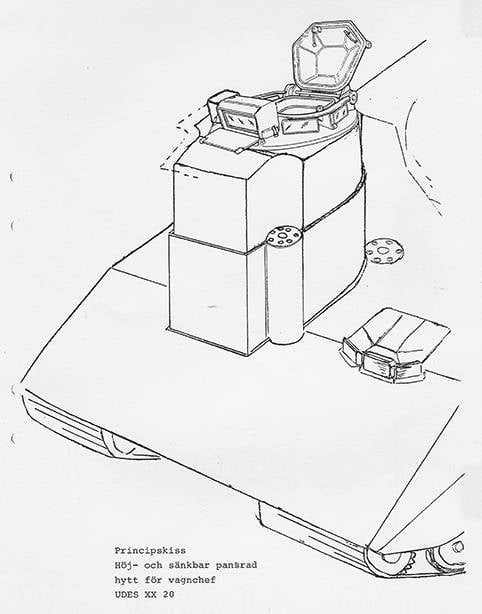
Lifting cabin commander. Figure Ointres.se
In the stern of the front hull of the tank UDES XX 20 should have been a turret assembly tower. On the pursuit of the hull, the back of which was placed on the support at the stern, was placed the turntable of the tower. It placed two tilted forward rack with a hinge for mounting a gun. The trunnions should have an 120-mm gun from the Rheinmetall company with a barrel of 44 caliber. The gun was equipped with advanced recoil devices and a muzzle brake of a characteristic shape. To protect against shelling, the breech of the gun had to be inside the case of complex multi-faceted shape. The gun mount received electrical and hydraulic pick-up drives, which allowed shelling targets in any direction within a significant vertical sector.
The project involved the use of automatic loader. Due to the lack of space inside the front section, the mechanized installation should have been located in the rear housing. In the same place it was planned to place and the manipulator for supply of ammunition to a gun. Access to the breech could be provided by a hatch in the body of the gun installation. When solving layout problems, such an automatic loader design, however, required after each shot to return the gun to the neutral position. However, it was possible to achieve a rate of fire at 7-10 per minute.
In the front hull of the tank UDES XX 20 had to work a crew consisting of three people. The driver and commander were in front of the hull, left and right, respectively. The gunner was supposed to be placed behind them. Crew members had their own hatches in the roof, complemented by viewing devices. To improve the view on the battlefield in the new project was proposed the original system. The workplace of the commander was planned to be placed inside a polygonal tubular cabin-glass of 20-mm armor. If it was necessary to study the terrain, such a cabin should have risen above the roof of the hull, leading the commander’s viewing instruments to the required height comparable to the height of the line of fire. In a combat situation, the commander, together with his cabin, was to return back to the corps.
The total length of the advanced tank with a cannon forward was 9,63 m, the length of the hulls was 7,4 m. The width was 2,9 m, the height of the roof of the gun mount was 2,6 m. The combat mass of the tank was determined at the level of 26 t. at level xnumx hp per ton, which allowed us to get the maximum speed 600 km / h.
In 1982, the company HB Utveckling AB with the participation of the Department of Defense FMV built a prototype of a promising tank. In order to work out various structural elements, it was proposed to carry out the first stage of testing without the use of a full-fledged gun mount. Instead, on the roof of the front section mounted a simplified unit of similar size and weight. As a model 120-mm gun on the simulator tower secured the pipe, not protruding beyond the bow of the hull. In addition, due to some problems of a production nature, an experienced tank did not receive the commander’s lift cabin. To protect the crew from external influences, a special frame was mounted on the front plate. Subsequently, it was removed several times from the tank and installed back. In this form, an experienced tank went to the first test sites.
For some time the prototype of an articulated tank drove along the tracks of the test range and overcame various obstacles, including quite complex ones. Sea trials fully confirmed the calculated characteristics of the chassis. As expected, the articulated vehicle was distinguished by high maneuverability in difficult landscapes and could overcome a variety of obstacles, including wide trenches and high walls. If it was impossible to overcome the obstacles due to the engine power and the tracks, the driver could change the mutual position of the two buildings, optimizing it for the current task. In this case, the rear section helped the front to cross the obstacle or to overcome the rise, after which she dragged her behind her.
Having completed the chassis check, the project authors sent a prototype for minor repairs and modifications. In addition, at this stage it was planned to equip the prototype with a full-fledged gun mount. According to the results of restoration and refinement, a full-fledged prototype of an experimental tank UDES XX 20 was launched at the landfill. At the same time, however, the car still did not have a mobile cabin commander and automatic loader. Otherwise, it is fully consistent with the existing project.
One of the main tasks of the next test phase was to test the impact of a relatively powerful 120-mm smooth-bore gun on a relatively lightweight chassis, divided into two sections. There was a risk of negative effects on equipment. For example, there were concerns that shooting at high angles of horizontal guidance could knock over a tank. In addition, it was necessary to determine other characteristics. weapons and features of its interaction with the chassis.
To determine the real capabilities of the tank, fire tests were conducted with shooting at all possible modes and pickup angles. When shooting with different angles of horizontal guidance, it was found that the muzzle brake and advanced recoil devices quench a significant part of the impact and reduce the negative impact on the machine itself and on its crew. In the absence of additional influencing factors, the tank did not risk falling on its side. Other firing characteristics were at an acceptable level and, in general, corresponded to the capabilities of 120-mm guns of other modern tanks.
In its current form, the promising tank had fairly high performance, but was not without flaws. First of all, the large dimensions of the frontal projection, which unmasked the car and increased the likelihood of its being hit by enemy fire, were criticized. In order to solve this problem, two new projects were proposed that used other tool assembly systems. For example, the design of the UDES XX 20B tank proposed a forward displacement of the gun mount, which made it possible to reduce the overall height of the vehicle and at the same time increase the angles of the vertical pickup. An alternative project UDES XX 20C meant moving the crew to the left side of the hull. On the right, accordingly, the rocking artillery unit should have been located. In this case, an even greater reduction in height was achieved. However, two additional projects did not advance beyond the preliminary development stage.
According to the results of testing an experimental tank UDES XX 20 lists of the advantages and disadvantages of such equipment were formed. They found high mobility to be positive, including on difficult landscapes and on soft grounds. The relatively low specific load on the tracks reduced the requirements for the strength of the soil capable of withstanding the machine. The ability to change the relative position of the two buildings became an additional means of improving the patency. The small size of the frontal projection (relative to other modern tanks of traditional appearance) was considered a factor that reduces the probability of finding a tank and increases its survivability on the battlefield. Another advantage was the movement of all crew jobs inside the hull. Placing ammunition in the rear section reduced the risks associated with mines. An explosive device could damage the front section, while the rear with stacking turned out to be relatively safe.
The most noticeable disadvantage of the project was the excessive complexity of production and operation associated with the need to manufacture two buildings at once and special systems for connecting them. The articulated layout also reduced the maneuverability of the vehicle: four tracks, even if there was a hinge, did not allow the tank to turn in place like other tracked vehicles. The articulated tank surpassed any other technique of classical architecture in the area of the onboard and upper projection. Open placement of the hinge and its hydraulic cylinders led to increased risks. When the hinge drives were damaged, the armored car lost most of its advantages in maneuverability and maneuverability. Bringing the automatic loader beyond the limits of the manned volume did not allow the crew to load the gun manually.
Tests of an experienced UDES XX 20 tank with a model of a combat module and a full-fledged turret continued from the beginning of 1982 of the year to March of 1984. As part of these works, the main characteristics and capabilities of the equipment were confirmed or clarified. In addition, the testers were able to identify all the existing shortcomings and determine the extent of their influence on the machine. After the tests were completed, the FMV management and organizations of the defense industry were able to continue the work on the development of armored vehicles, taking into account the collected data and the experience gained.
The proposed project of a promising tank of an articulated structure was of great interest to the army due to obtaining sufficiently high technical and combat characteristics. Nevertheless, the car had a number of serious flaws of production and operational nature. Given the prospects and opportunities, it was decided not to continue the development of the project UDES XX 20 or other similar equipment in order to further create a full-fledged combat vehicle for the army. The military decided that there would be more benefit from the new projects of traditional architecture tanks. The pilot project completed the tasks, after which it was closed.
The only built prototype tank UDES XX 20 was written off and went to storage. Subsequently, a unique sample of armored vehicles was transferred to the Stockholm Museum Armémuseum, where it remains to this day.
As part of two pilot projects with the letters “XX” in the names, Swedish specialists were able to determine the real characteristics and capabilities of articulated tanks. According to the analysis of the pros and cons, it was decided not to launch such a technique in the series. For the future renewal of the military equipment fleet, it was now necessary to develop less daring projects. Subsequent armored vehicles of the Swedish development were to be built according to traditional schemes. New designs of articulated tanks and combat vehicles were still being considered, but were no longer brought to the testing stage, let alone serial production. Sweden refused to use non-standard ideas in the field of armored vehicles. The accumulated experience in the field of the further development of tanks was never fully realized.
On the materials of the sites:
http://ointres.se/
http://btvt.narod.ru/
http://arsenalen.se/
http://strangernn.livejournal.com/
http://warfaretech.blogspot.fr/
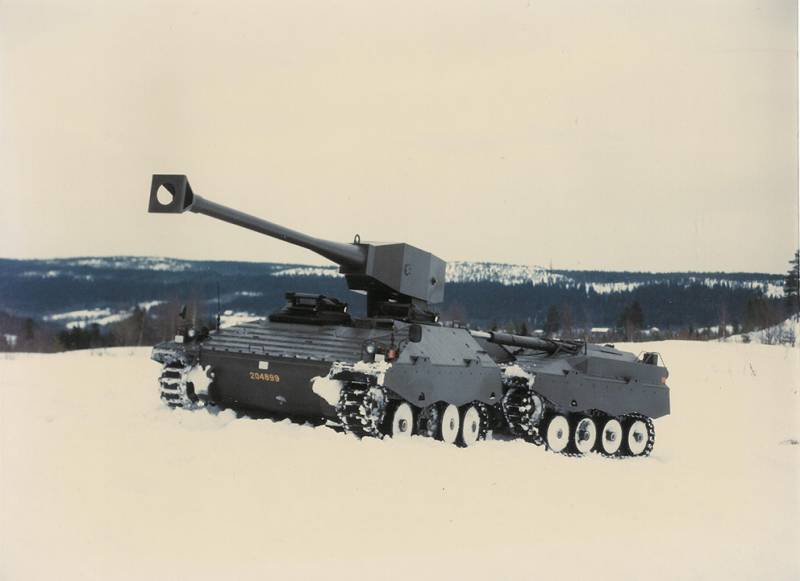
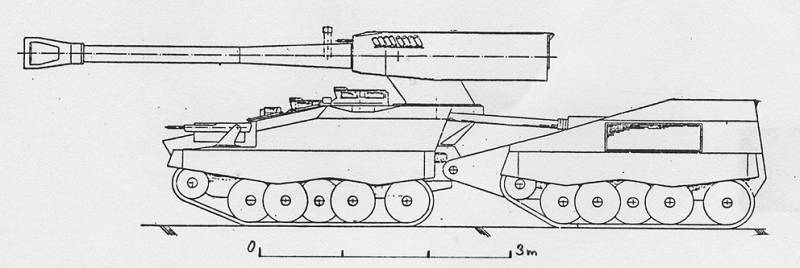
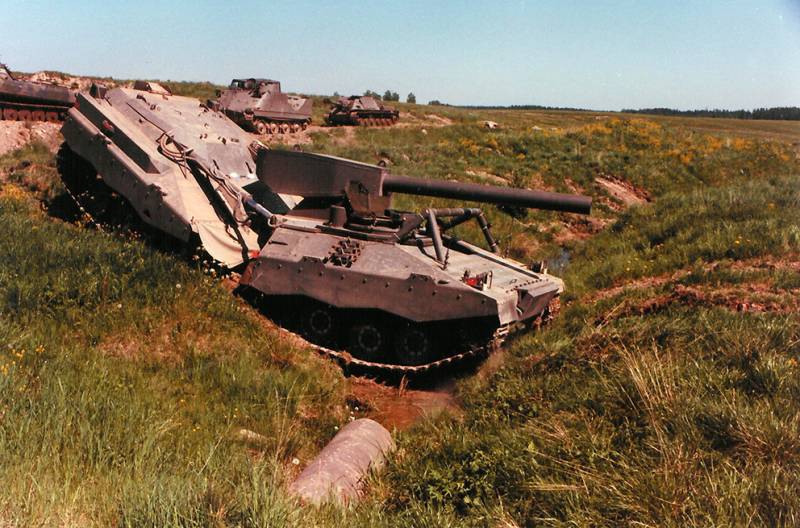
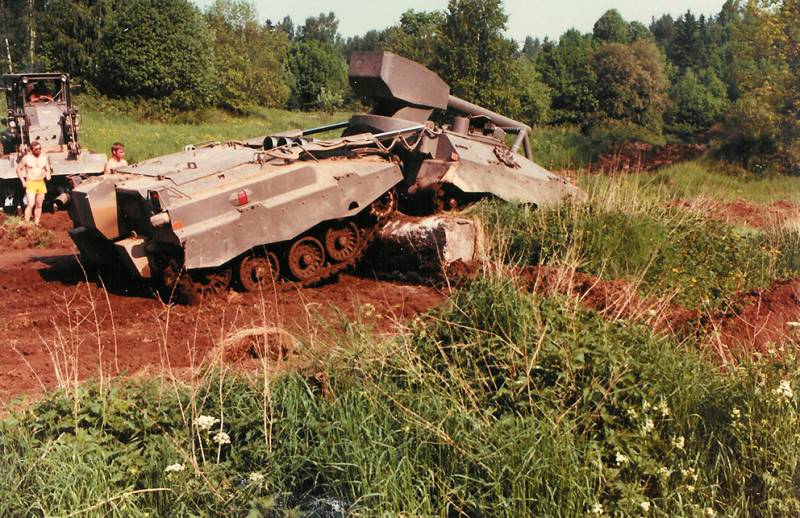
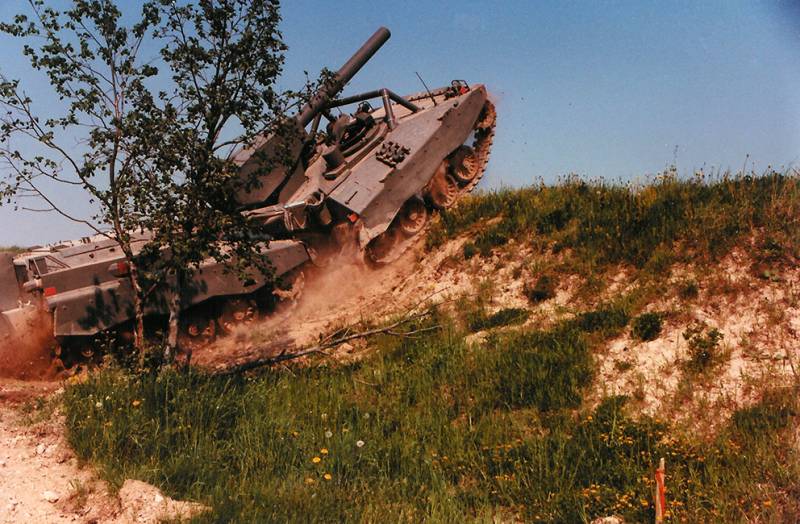

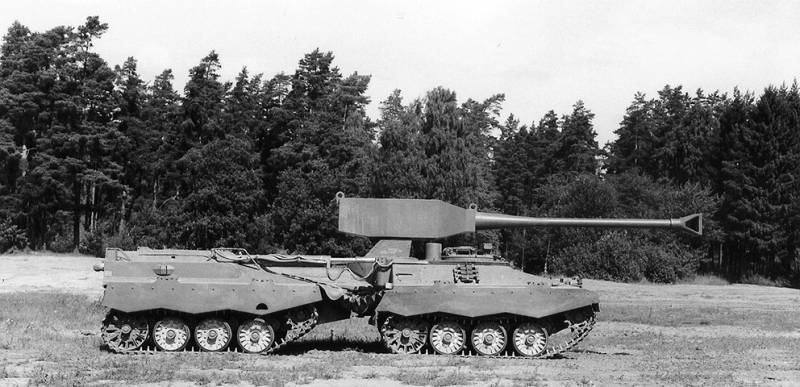
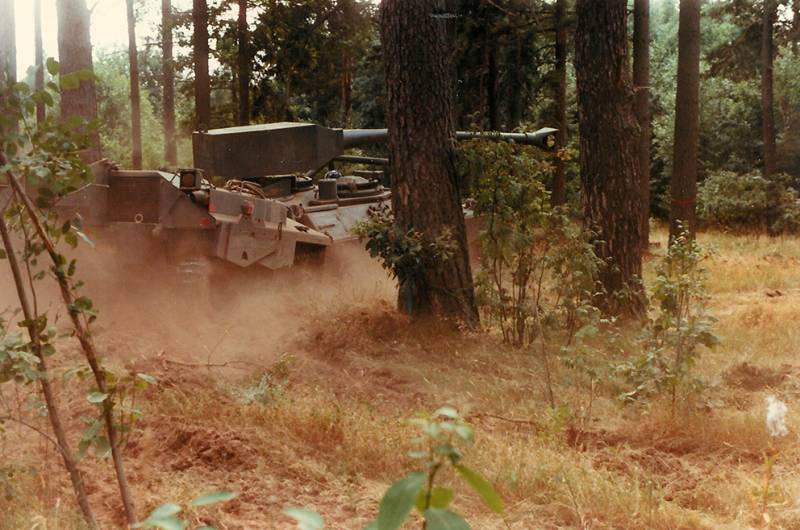
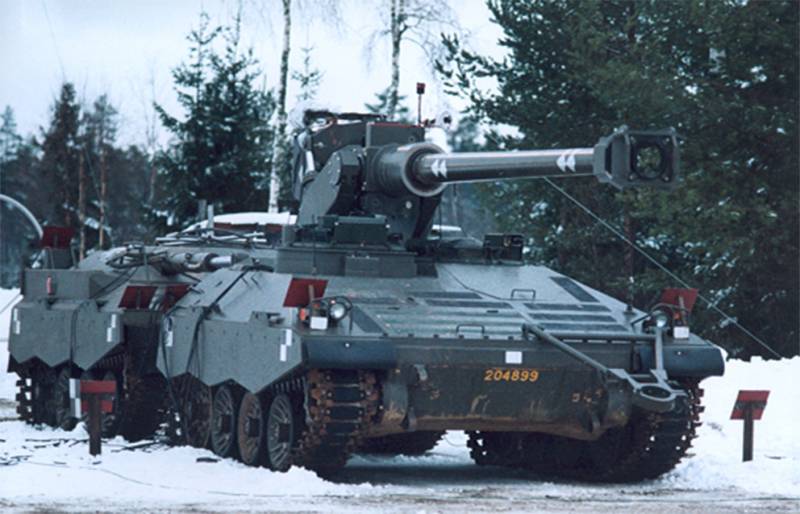
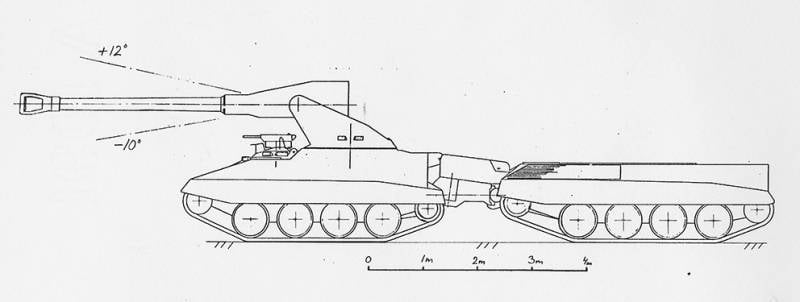
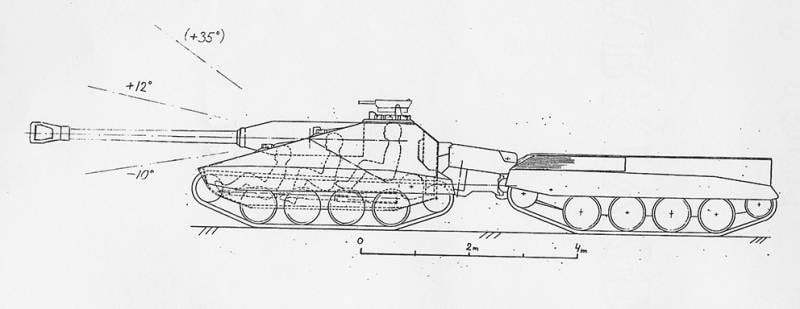
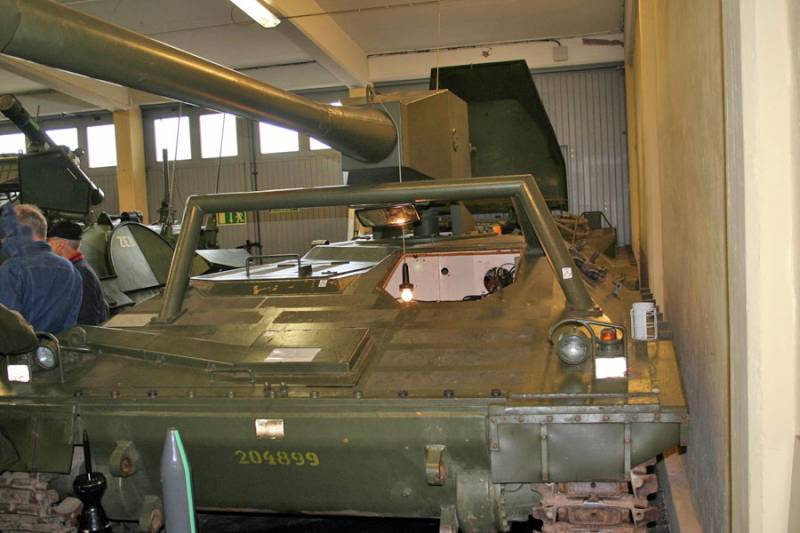
Information